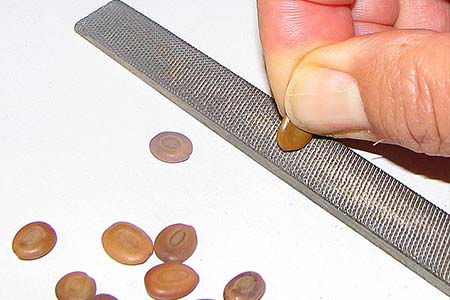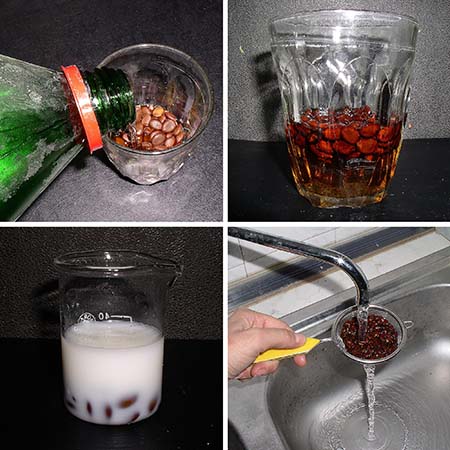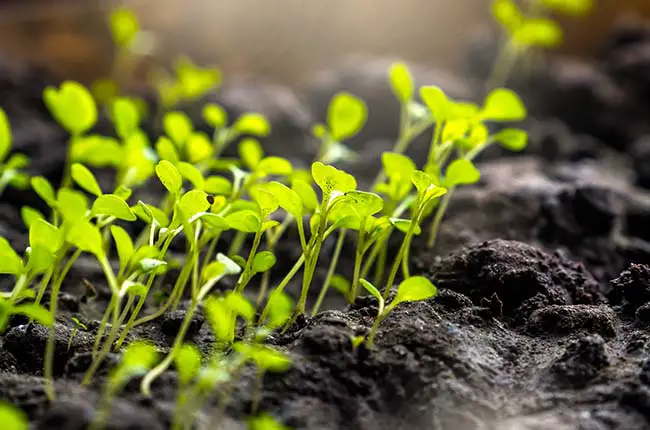If you plant seeds and they still do not germinate after waiting for weeks, chances are the seeds could just be dormant.
How can you make dormant seeds germinate?
To break seed dormancy, you can physically crack open the hard outer seed coat using a sharp tool, soak them in strong acids (or vinegar for home gardeners) to weaken the seed coat, stratify them in a moist, cold environment of 32-41°F (0-5°C) over 1 to 3 months, and expose them to strong cool-white or infrared light, and hormones.
In this article, we will look at 5 techniques used to break seed dormancy and find the best one for home gardeners.
Let’s get started.
1. Mechanical scarification
The methods used to break seed dormancy are called “scarification” and can be done in different ways by physically weakening, opening, or altering the coat of a seed to encourage germination.
Mechanical scarification involves physically breaking or cracking open the hard outer coat of seeds that is impervious to water and oxygen.
To do so, a tool, such as a knife, a hammer, a nail clipper, a metal file can be used. For example, a nail clipper can be used to nick the pointed end or the opposite end of the area that looks like an “eye spot”. Also, you can roll seeds over sandpaper or shake seeds inside a container for about a minute. Mechanical scarification also occurs naturally during the freezing and thawing process in which the seed coat is broken.
The goal is to weaken the seed coat to let moisture and air enter the embryo of the seed more easily to encourage germination.
This technique is suitable for seeds with a hard coat, such as pumpkin seeds, nuts. It should not be used on soft seeds, such as peas, beans, as it can damage the embryo. Also, the procedure should be done just before sowing, as it can leave seeds vulnerable to decay.

(Gmihail at Serbian Wikipedia, CC BY-SA 3.0 RS, via Wikimedia Commons)
2. Cold stratification
Putting seeds under a low temperature over a period of time, also known as “cold stratification”, is to mimic the transition of winter to spring to encourage germination.
For most temperate plant seeds, putting them under a low temperature of 41°F (5 °C) over at least 1 month can stimulate seed germination.
For most home gardeners, you can stratify seeds by putting them in the refrigerator. Mix seeds with an equal volume of a moist medium (sand or peat for example) in a closed container (or with a plastic wrap around it) to lock in moisture and put in the refrigerator for 1-2 months. Then, place it in a warm indoor area with the plastic wrap in place until the seeds have germinated.
To stratify a large batch of seeds, an easier way to do this is to sow directly on the ground in the fall for them to germinate in Spring.
Seeds from cold climate species especially perennials that are used to long periods of snow cover and severe winter require much lower temperature and over a longer period to stratify. For example, a perennial herb that is used to the long cold winters in the mountains is found to have a higher germination rate (60%) after being exposed to a low temperature of 32 °F (0 °C) for 7 months (Cuena-Lombraña et al., 2018).
3. Chemical scarification
Seed dormancy can also be broken by soaking them in chemicals such as acidic or basic solutions, organic solvents, alcohol, disinfectants, or boiling water. The aim is to dissolve or alter the outer coat of seeds, encouraging germination.
Common acids used to scarify seeds include phosphoric acid (25 to 75% concentration depending on the type of seed), potassium nitrate, nitric acid, and sulfuric acid (96%). For most gardeners, handling these highly erosive acids can be dangerous and a safer alternative is vinegar although it is less effective.
Bases are also used, the most common being sodium hydroxide and hydrogen peroxide (3% concentration) for harder seeds.
The type of chemical, its concentration, and the length of immersion can vary with the type of plant seeds. For example, the seeds of a tropical herb (Centrosema rotundifolium) may need a 32-minute-long immersion period of sulfuric acid, much longer than the seeds of Chili pepper (Capsicum annuum) which require only 10 minutes to see an improvement in germination (Evans & Blazich, 1999).

(Gmihail at Serbian Wikipedia, CC BY-SA 3.0 RS, via Wikimedia Commons)
4. Light treatment
Exposing seeds to strong cool-white and infrared light can also break the dormant state of some seeds as they mimic the natural environment during spring and summer.
Good results were observed with both cool-white and red light (90 to 100% germination rates), while germination rates were low in blue and green light (10 to 20%) (Penfield et al., 2005; Li, Liu & Khan, 2005).
The light source should be close to the seeds and should be on for at least 8 hours daily in a moist environment under a low temperature. After receiving the light treatment, the seeds should be incubated in the dark until germination.
Also, light treatment during the germination periods is particularly key in affecting how plants grow and their vigor. For example, seedlings that germinate under LED light grow taller and have thicker roots compared to plants that grow in the dark or under fluorescent lights. The effects of light treatment are visible during the first 6 months of the plant’s life (Li, Liu & Khan, 2005).
However, light treatment does not break seed dormancy, and in fact can inhibit germination of some seeds.
Related: What Seeds Need Light To Germinate? (List Included)
5. Treatment with hormones
Seed dormancy can also be broken by directly applying five types of plant hormones: abscisic acids (ABA), gibberellin (GA), brassinosteroids (BRs), ethylene, and jasmonic acid (JAS).
Seeds can become dormant or active depending on the balance of endogenous hormones in the seeds. For instance, ABA and JAS control the status of seed dormancy and inhibit germination. On the other hand, ethylene, GA, and BRs promote germination.
Studies have shown that gibberellin (GA) is the most effective in inducing germination with over 25% success rate (Shu et al., 2016). The hormone functions by softening the endosperm, promoting embryo growth, and facilitating the seedling to break out of the seed coat.
Hormone treatment is an effective way to promote germination and break seed dormancy for soft seeds, but has limited effects on hard seeds because water cannot penetrate the hard outer coat.
6. Best way to break seed dormancy?
The quickest way to break seed dormancy depends on the seed, but many studies have shown that a combination of the scarification techniques (especially mechanical scarification and temperature treatment) would be the best.
In one study, the most effective method for breaking the dormancy of the Mimosa bimucronata seeds was hot water at 176°F (80 °C) for one minute, followed by immersion in water at room temperature for 24 hours. Mechanical scarification using sandpaper was also used.
A study on breaking the dormancy of Prunus yedoensis seeds also found the best germination rate (40%) when the seeds were chemically treated, washed, and stratified for 9 weeks (Kim, 2019).
Conclusion
Dormancy is the natural state of seeds where the embryo matures.
Mechanical, chemical, temperature, light, and hormonal treatments can be employed to break dormancy, with varying results depending on the type of seeds.
For home gardeners, the best is to use a combination of techniques, especially mechanical and temperature treatments.
Happy gardening!
Related
What Seeds Need Light To Germinate? (List Included)
How Long Do Seeds Last? (And How to Store Them)
Saving Seeds from Green, Unripe Fruits? (We Investigate)
References
Cuena-Lombraña, A., Porceddu, M., Dettori, C. A. & Bacchetta, G. (2018). Discovering the type of seed dormancy and temperature requirements for seed germination of Gentiana lutea L. subsp. lutea (Gentianaceae). Journal of Plant Ecology, Vol 11 (2), Pp. 308–316
Evans, E. & Blazich, F. (1999). Overcoming Seed Dormancy: Trees and Shrubs.
Okon, O., Akpan, G. & Ekong, C. (2014). Effect of Different Treatment on Seed Germination and Breaking of Seed Dormancy in Capsicum annuum Effect of Different Treatment on Seed Germination and Breaking of Seed Dormancy in Capsicum annuum. International Journal of Research, Vol 1, 8.
Kim, D. H. (2019). Practical methods for rapid seed germination from seed coat-imposed dormancy of Prunus yedoensis. Scientia Horticulturae, Vol 243, Pp. 451-456
Li, W., Liu, X. & Khan, M. A. (2005). Hormonal and environmental regulation of seed germination in flixweed (Descurainia Sophia). Plant Growth Regulation 45(3):199-207
Penfield, S., Josse, E., Kannangara, R. Gilday, A. D., Halliday, K. J. & Graham, I. A. (2005). Cold and Light Control Seed Germination through the bHLH Transcription Factor SPATULA. Vol 15 (22), Pp. 1998-2006
Shu, K., Liu, X. D., Xie, Q. & He, Z. H. (2016). Two Faces of One Seed: Hormonal Regulation of Dormancy and Germination. Vol 9 (1), Pp. 34-45
- 5 Ways To Break Seed Dormancy: Which is the Best? - May 22, 2022
- Ants in Garden: 7 Ways to Remove Them (Naturally) - April 23, 2022
- Top 19 Plants with Aerial Roots (With Pictures) - April 17, 2022

